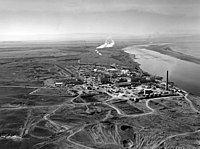
Photo from wikipedia
ABSTRACT There are several important radionuclides involved in the "clean-up" or environmental isolation of nuclear waste contained in US Department of Energy Hanford Site underground waste tanks that drive many… Click to show full abstract
ABSTRACT There are several important radionuclides involved in the "clean-up" or environmental isolation of nuclear waste contained in US Department of Energy Hanford Site underground waste tanks that drive many of the decisions associated with this activity. To make proper human health risk analyses and ensure that the most appropriate decisions are made, it is important to understand the radiation biology and the human health risk associated with these radionuclides. This manuscript provides some basic radiological science, in particular radiation biology, for some of these radionuclides, i.e., 3H, 90Sr, 137Cs, 99Tc, 129I, and the alpha emitters 239, 240Pu, 233,234,235,238 U, and 241Am. These radionuclides were selected based on their designation as "constituents of potential concern," historical significance, or potential impact on human health risk. In addition to the radiobiology of these select radionuclides, this manuscript provides brief discussions of the estimated cost of planned management of Hanford tank waste and a comparison with releases into the Techa River from activities associated with the Mayak Production Association. A set of summary conclusions of the potential human health risks associated with these radionuclides is given.
Journal Title: Health physics
Year Published: 2022
Link to full text (if available)
Share on Social Media: Sign Up to like & get
recommendations!